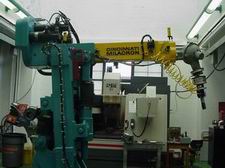 An industrial robot is officially defined by ISO as an automatically controlled, reprogrammable, multipurpose manipulator programmable in three or more axes.
An industrial robot is officially defined by ISO as an automatically controlled, reprogrammable, multipurpose manipulator programmable in three or more axes.
At Cincinnati Milacron Corporation, Richard Hohn developed the robot called The Tomorrow Tool or T3. Released in 1973, the T3 was the first commercially available industrial robot controlled by a microcomputer as well as the first U.S. robot to use the revolute configuration.
This robot is a more classically designed industrial robot. Designed as a healthy compromise between dexterity and strength this robot was one of the ground breakers, in terms of success, in factory environments. However, while this robot was a success in industry its inflexible interfacing system makes it difficult to use in research.
The Cincinnati Milacron T3 robot is an example of jointed arm robot which most closely resembles the human arm. This type of arm consists of several rigid members connected by rotary joints. In some robots, these members are analogous to the human upper arm, forearm and hand; the joints are analogous to the human shoulder, elbow and wrist.
The T3 robot arm is mounted on a rotary joint whose major axis is perpendicular to the robot mounting plate. This axis is known as the base or waist. Three axes are required to emulate the movement of the wrist and they are called: pitch, yaw and roll.

CONTROL SYSTEM
The T3 robotic arms is controlled using a Hierarchical Control System.A Hierarchical control system is partitioned vertically into levels of control. The basic comand and control structure is a tree, configured such that each computational module has a single superior, and one or more subordinate modules. The top module is where the highest level decisions are made and the longest planning horizon exists. Goals and plans generated at this highest level are transmitted as commands to the next lower level where they are decomposed into sequences of subgoals. These subgoals are in turn transmitted to the next lower control decision level as sequences of less complex but more frequent commands. In general,the decisions and corresponding decompositions at each level take into account: (a) conrmands from the level above, (b) processed sensory feedback information appropriate to that control decision level, and (c) status reports from decision control modules at the next lower control level.
The figure shown above depicts the schematic block diagram of the integrated control structure as configured on the Cincinnati Milacron T3 Robot. The system is configured in the hierarchical manner and includes five major subsystems:
(1) The Real-Time Control System (RCS)
(2) The commercial. T3 Robot equipment
( 3 ) the End-Effector System
(4) The Vision System
(5) The Watchdog Safety System
The Real-Time Control System as shown in figure is composed of four levels:
(1) The Task Level
(2)The Elemental-Move Level
(3) The Primitive Level
(4)The T3 Level.


